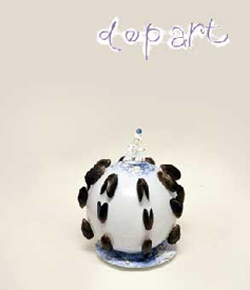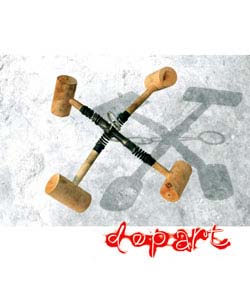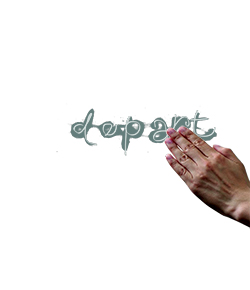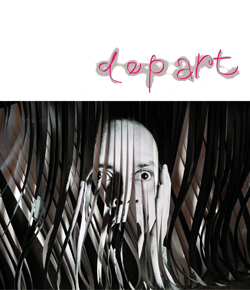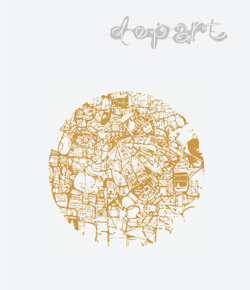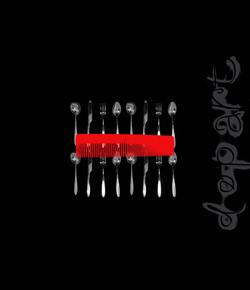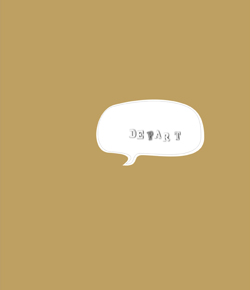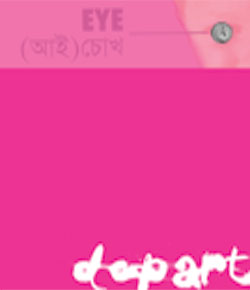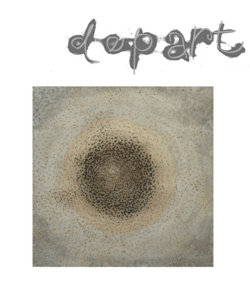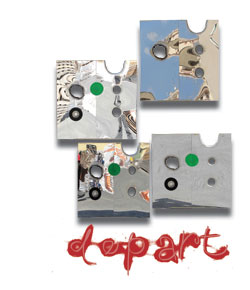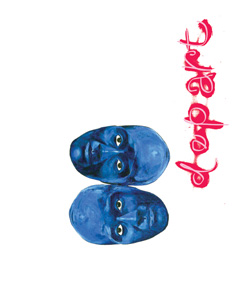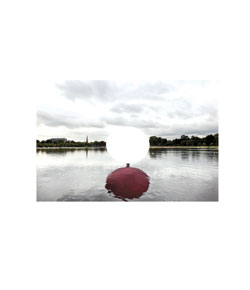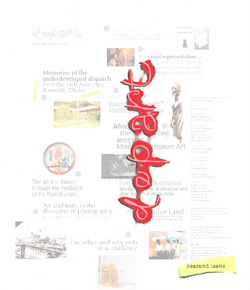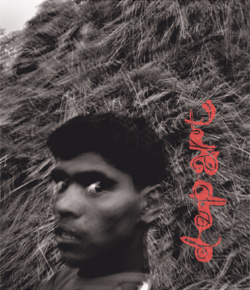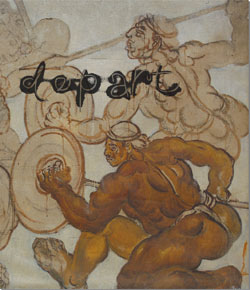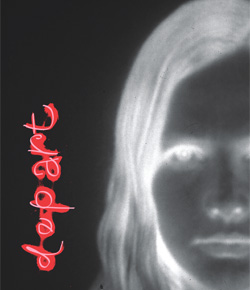Features
A checkerboard of plurality
the Chobi Mela VIII expo

We have arrived at a hyper-capitalist age, if you will, free market bringing exponentially into its service free dissemination of fast-tracked digitized information/visual imagery; this info/visual fleet remains as unregulated as capital, except that unlike capital its free fair flow percolates the farthest corner of the globe at a single punch of the finger. This prolifically circulating imagery is mostly encoded in universal registers of signs and intimations not unfamiliar to its culturally global but geographically divergent population of recipients. Pelted incessantly by these repetitive visuals one tends to turn a blind rather than a critical eye towards the ubiquitous traffic.

However, once an image succumbs to materiality in printed form, it is a tangible end product, often an art object after being sucked into the vortex of the art circuit. A photograph is more than a documentation, it is a conscious spin on the zeitgeist, especially when creative awareness and passion fuels the engine of its 'making'. Chobi Mela in its VIII(th) appearance shows a restrained, mature approach to the visual culinary presented before the audience testifying to a conceptual percipience at play in its composition.
Chobi Mela, baptized unassumingly, yet encompassing the breadth of a 'mela', a fair, like a decorated veteran, one of its kind in South East Asia strides on to the effulgence of a marching band attuned to the shifts of time, growing more valiant with each passing edition. The 'fair' grounds wide and varied bear a slew of heraldic festoons in the form of exhibits from far afield, cutting a wide swathe across the globe and a conciliatory one across an uneasy division, bringing within its fold both visual artists and photographers; yet again highlighting the pertinence of photograph as a versatile art form. In keeping with its name and the verisimilitudes of a festival there was a buzz of activities spanning exhibits, artists talks, workshops centering on the pivotal precept of multidisciplinary dialogue. Thwarting occasions of rigid regimentation, this allowed for a spatial palimpsest with strands of mediums, techniques and strategies running parallel, sometimes overlapping but purportedly converging under the unified banner of 'Intimacy'.
It is the wisp of a moment, flighty, elusive, ethereal, committed to memory, in its nostalgic crepuscular gleam that intimacy finds its abode, in the personal domain, so extrapolates the festival director, Shahidul Alam. Who also bemoans the fact how global capital corrupts the essence of intimacy and relegates it to a marketable fetish.

We invite photographers to probe into the depths of personal space.... To challenge perceptions of belonging... ideas of ownership... bring back stories of intimacy that will touch our souls and fire our imagination.
It is excruciatingly difficult to descend upon the idea of space, more so if it is defined as the personal. A person is a performative agent who spins out narratives of life at different levels of his contact with different perspectives of reality. The personal space is the locus of one's idiosyncratic negotiations with the successive outer layers that again cros-cut each other to form his reality; the social-cultural, religio-racial, local/global- political sprawl. The idea of 'beingness' is a mirror unto itself, not a consistently unified whole, rather a 'becoming', a persistent transitioning as reflected on the mirror that shows constant shift of variables around the subject, just like the frame of a photograph wherein the subject becomes the object of a subjective gaze, and in this - the intermediary, dialectical in-between space between one subject and the other- one might arguably furnish the space of intimacy.
The photographed space is more consciously chosen than the actual space. There is an act of 'staging' which is performed. Luis Gonzalez Palma's (Guatemala) The Annunciation appropriated The Northbrook Hall's (an old theater house) heritage ambience to springboard a double-entendre: re-territorializing an errant self as well as the omnipresent invisible 'other', in an intimate space of internal dialogue, where both silently and cognitively co-create a state of familiarity, recognition of a peculiar state of being. Here is seen an alienating force, curiously Ayn Randian in nature, that pulls individuals apart to land them on their own desert islands. Plus, the theatrical echo of 'a stage within a stage' was an interesting curatorial intervention, especially in Bangladesh, that seems to toe the line of a current trend of appropriating semi abandoned historical sites for staging art following examples of the West. One is again tempted to glance back at how conspicuously Annunciation and Northbrook Hall were lumped together. Nevertheless, the witty and playful contents of the photoshopped mélange in no mean feat redefined the 'space' inhabited by the sheer power of its aesthetic iteration.

Many an exhibit gracing the festival testifies to the 'truth' of space as an imaginary construct that finds an abstract formulation in the idea of intimacy, an idea of 'belonging' which human beings conceive as most essential for their existence. In this regard Michel Le Belhomme (France), The Blind Beast, deserves mention. The images are of the nature of artifice, candidly extra-medial, borrowing heavily from the architecture of space, displaying simultaneous courses of reconstruction/deconstruction, where interiority of a fear of loss as well as regain synthesizes in the seemingly static images of spatiality redolent with fragmented narratives of reclaiming a habitat of one's own in the midst of a fictive reality that is at the same time illusionary, and in a state of flux. The 'beasts' (images) in view, reel out as an internal discourse that stands opposed to photographs as instances 'encapsulated in a moment in time', as they relentlessly remind and participate in a process of advancing towards the beyond. One quandaries the works for their (non/)representation of space and time with a subconscious urge to identify with its indeterminacy.
A Pause to Breathe by Tapash Paul (Bangladesh), was showcased in an open air location, the renowned 'Bokultala' on the premises of the Faculty of Fine Arts. A reprieve, away from the confines of the 'cube', these images record the magical properties of nature in varied nuances. The composition of lines, curves and contours in muted and resplendent colours is reminiscent of the 'impressionistic' maneuvering of the laws of optics. According to the 'author' the series represents the poetics of the triangular ecology of nature, man, and animal. Laced with a sense of nostalgia, these photographs make for sheer optical delight.

Yusuf Servincli (Turkey) is a 'flaneur' who prowls the labyrinths of the urbanscape sleuthing for the secrets and the urban lores that threaten to unmask its serendipity. The series Clairvoyance is a repository of images befitting the epithet; grainy, sratchy, pigmenty in texture, the 'haze' is consciously wrought to overturn the notion of commonly perceived 'momentousness' of a photograph. Eerie yet playful, the works wink at the audience in a gesture of good-humoured challenge that defies easy reading. The images are released from their steely suspension into an eddy of shock and surprise; long exposure unfolding time in a contrapuntal fluidity. It apparently reads like a quest for the mysterious soul of a place, as reflected on the carnivalesque painting on the face of a girl; eyes shut, evading the gaze, lost in a reverie that transcends the traps of time yet materially conjunct with a situatedness as signified by the spectacles slinging from her neck.
In the carnival of interdisciplinary mobility generic practices are constantly being improvised as dialogic cross genre interexchange takes place. However, when cloistered within a single thematic rubric, there might appear the possibility of a mischance in the shape of a debilitating receptive saturation on the part of the audience. The titular gambit might subliminally regulate the mind to trace the insistent common thread that professedly strings the works together, thus inhibiting our 'way(s) of seeing' from locating alternative stories/unorthodox streaks that might lie unbidden in the deeper ends of a particular work. Moreover, the contextual basis of an individual series of work is made to fall in line with the rest of the contingent, in as much as coherence is achieved; yielding to ersatz curatorial regimentation. What comes to light as one walks through such a global congregation is how vernacularity is denuded in the aural/visual frequency of a discursive field that follows the meta-logic of international 'contemporaneity' (or the in-thing) which feels more fixed and unyielding than fluid and flexible. Diversity is unified or collated to fit the 'frame', visually and conceptually. The 'scopic' of a multiplicity of angles is restricted by a 'telescopic' suggestion, pointing to a remote gleam at the end of the tunnel. On a sanguine note, every image when mediated by the 'gaze' engages the viewers on levels that are innate and unrestrained, eliciting responses outside the dictates of objective framing. Two exhibits illustrate how representations of identity owe much to their porous matrices which help transform the discourses at every point of an intra-perspectival encounter.

Rotimi Fani-Kayode (UK/Nigeria) delved into the 'spirit' of sexuality through his magico-psychic expose that comprises images of male bodies edified/elevated by an enlightened inner-consciousness. An homage to his roots, or more of a journey to the inner recesses of the unconscious, his photographs evoke the mystic of the manna by the re-enactment of ancestral spiritual rites. The almost tactile, sensual nature of the images stand out in their sublime aesthetics and poetics of spirituality. The glint of the pointed knife, the awe-inspiring tug of the strings serve nothing less than creating a space of intimacy to irrupt by the power of the images between the seen and the seer, one that is tainted with the desire for the unknown, the summoned.

Nepal Picture Library presented Retelling Histories a series extracted from a historical archive, an initiative by photo.circle. The collection is a mnemonic survey of the past that seeps into the present through the portal of a wondrous galore of photographs from vintage private collections, enabling telltale insights into recounting a nation's course through time. This exposition is shorn of artifice and artistic ambition, it proposes a social documentation, rooted in vernacular ethos. The first wearing the raiment of the erotic, the latter a pared down native narrative, voluntarily shift shapes and change colours upon entering a distant cultural arena, to converse with a sensibility both unfamiliar and universal.
Shirin Neshat (Iran), was represented by Turbulent, a dual channel audio/video installation that queries the disparity of gender relation through the visualization of a pair of operatic performances. More precisely it is the visualization/staging of a 'play' on reversed binarism; one channel featuring a male, the other a female, facing off from opposing walls, that Shirin instrumentalizes to reassign gender values. It is not the topicality- which remains unambiguous, but the technicality of its execution that serves as a virtuous vehicle to sally the message forth. Engaging Neshat as a voice in the narration of Chobi Mela lent its register a higher pitch by expanding the narrative scope through an intercourse of mediums, no doubt, however, one may wonder at the curatorial blindsight that led to Neshat's exposure through a repertory whose original release dates way back. Though widely celebrated, Turbulent's launching at Chobi Mela is a disservice to the local audience unsuspectingly denied the privilege of a more recent work.
Another multidisciplinary confluence took place under the banner of Sculpting with Light, a workshop with artist Mahbubur Rahman at the helm. The most notable work that came out of the inter-genre traversal is Monir Mrittik's reworking of Rene Magritte’s The Lovers Redux. A product that belongs to the medium of photoweaving, in which printed materials were woven to form a tapestry that shows veiled lovers locked in an eternal kiss. Their identity subsumed under the essentiality of the gesture of intimacy, of human contact, the need for proximity with that which is deemed invaluable and life-giving. Which, in the image remained unidentified, yet whose solid presence can be felt in all subjective expressions of desire. This work was also mounted in an ingenious hand carved frame.
Grounded more or less in a 'modality' of resistance to the sanitized space of the white cube, besides the customary venues of Shilpakala and National museum – the musty lighthouses of high art – many an alternative space; Northbrook Hall, Beauty Boarding, Bulbul Lalitkala, Bokultala were seen to play host to a number of exhibits. In the manner of an atavistic throwback these places were appropriated for their immersive cultural clime, and in virtue was a laudable effort to revive their almost forgotten charm back in public (somnolent) imagination.
Panning across 30 concurrent exhibitions, a cavalcade of workshops, designed to address both the pedagogy and the appreciation of photography, spearheaded by a concourse of learned curators, Chobi Mela VIII was a gala event–one that astounds and informs, and trains/sensitizes the mind and the gaze to explore the rare glimpses of magic and conceit in the expansive elasticity of aesthetic cross-currents. Mobilized, perhaps by a plenary vision to create a culture of inclusion, cross over, Chobi Mela VIII does ignite a conversation between counternarratives; whose embers simmer and glow in a diversity of meanings






